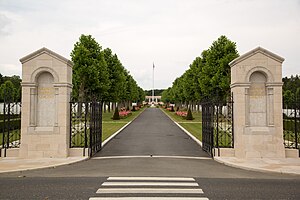Oise-Aisne American Cemetery
| Oise-Aisne American Cemetery and Memorial | |
|---|---|
| Battle Monuments Commission | |

Oise-Aisne
|
|
| Used for those deceased World War I | |
| Established | 1918. (Concentration cemetery 1921) |
| Location |
49°12′8″N 3°32′54″E / 49.20222°N 3.54833°ECoordinates: 49°12′8″N 3°32′54″E / 49.20222°N 3.54833°E near Fère-en-Tardenois, France |
| Designed by | Cram & Ferguson, Boston, Ma. George Gibbs, Jr. (LANDSCAPE) |
| Total burials | 6012 |
| Unknown burials | 597 |
|
Total commemorated
|
241 |
| Statistics source: Cemetery booklet | |
The Oise-Aisne American Cemetery and Memorial is an American military cemetery in northern France. Plots A through D contains the graves of 6,012 American soldiers who died while fighting in this vicinity during World War I, 597 of which were not identified, as well as a monument for 241 Americans who were missing in action during battles in the same area and whose remains were never recovered. Included among the soldiers here who lost their lives is poet Joyce Kilmer.
A graveyard for former soldiers that were dishonorably discharged and executed for crimes committed during World War II, referred to as Plot E, is nearby. Private Eddie Slovik, the only American soldier executed for desertion during World War II, was buried there until 1987.
The Oise-Aisne American Cemetery and Memorial lies one and a half miles east of Fère-en-Tardenois, Aisne, Picardy, France and about 14 miles (23 km) northeast of Château-Thierry. It is approximately 70 miles (110 km) northeast of Paris.
The grounds extend to 36.5 acres (14.8 ha) and this is the second of eight large permanent American World War I military cemeteries that are not in the United States. It was initially established on August 2, 1918 by the 42nd Division as a temporary cemetery, but was retained as a permanent cemetery by Congress in 1921. The French government provides the site at no cost for use as a military cemetery. The memorials were designed by Cram and Ferguson and the landscape architect was George Gibbs, Jr.
The cemetery is generally rectangular in shape. The chapel, museum and grave plots are one side of the road and a parking area and the service facilities on the other side. The plots are divided by a walkway with a circular island of grass in the middle. The sides of the cemetery include paths, a privet hedge, and a low stone wall.
...
Wikipedia
